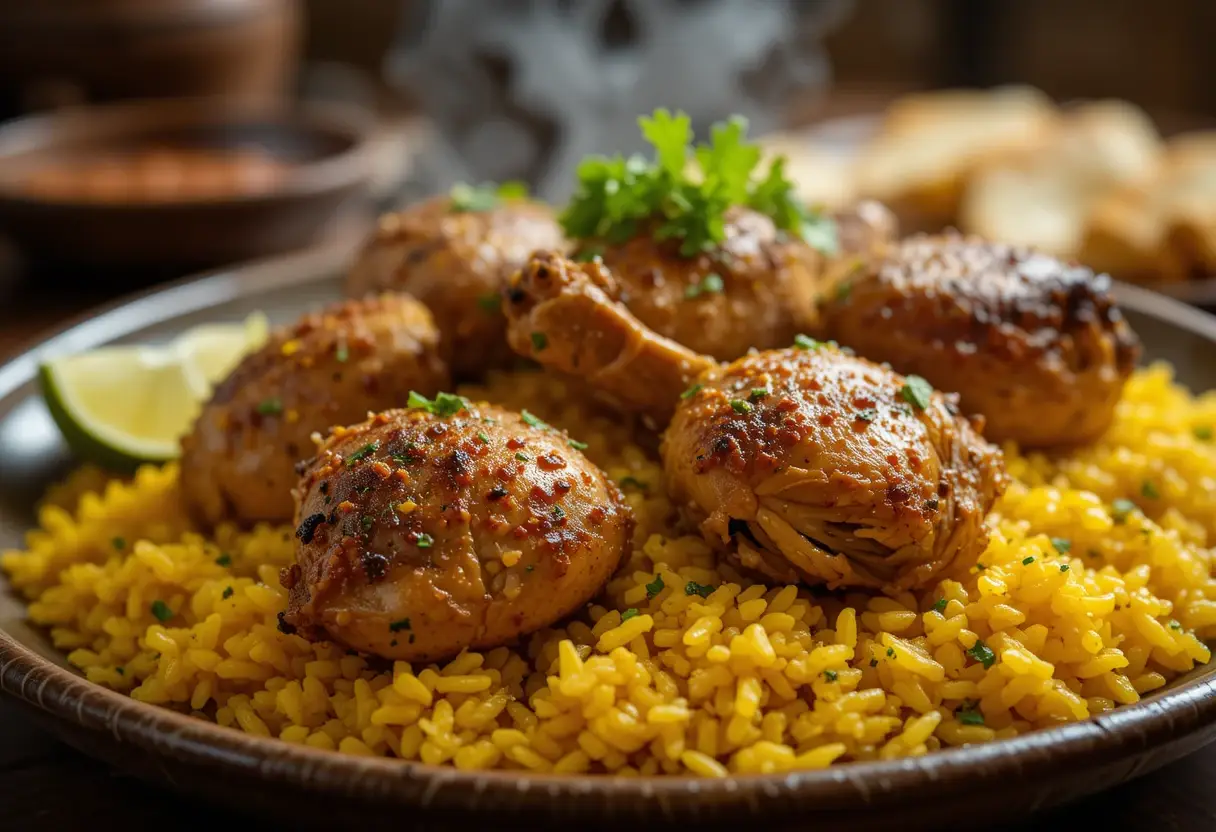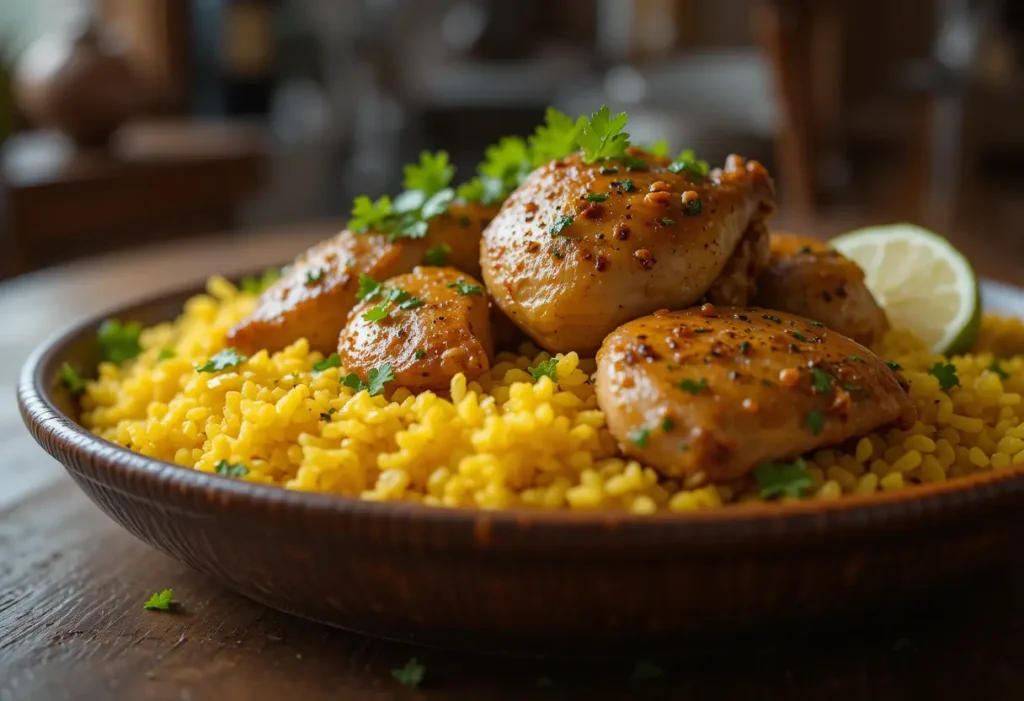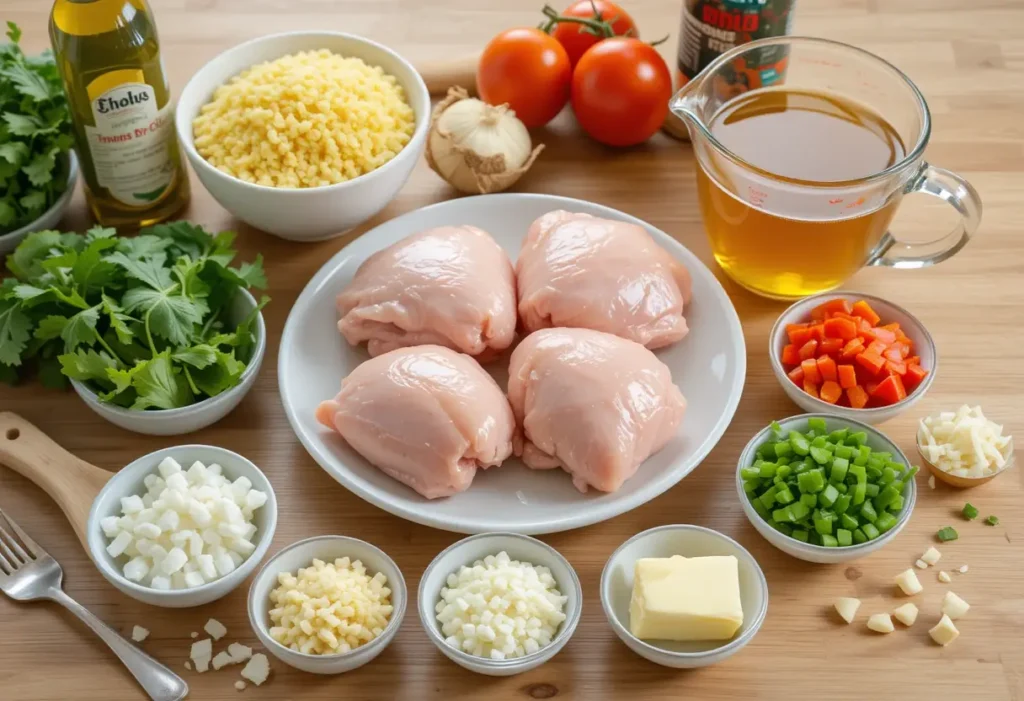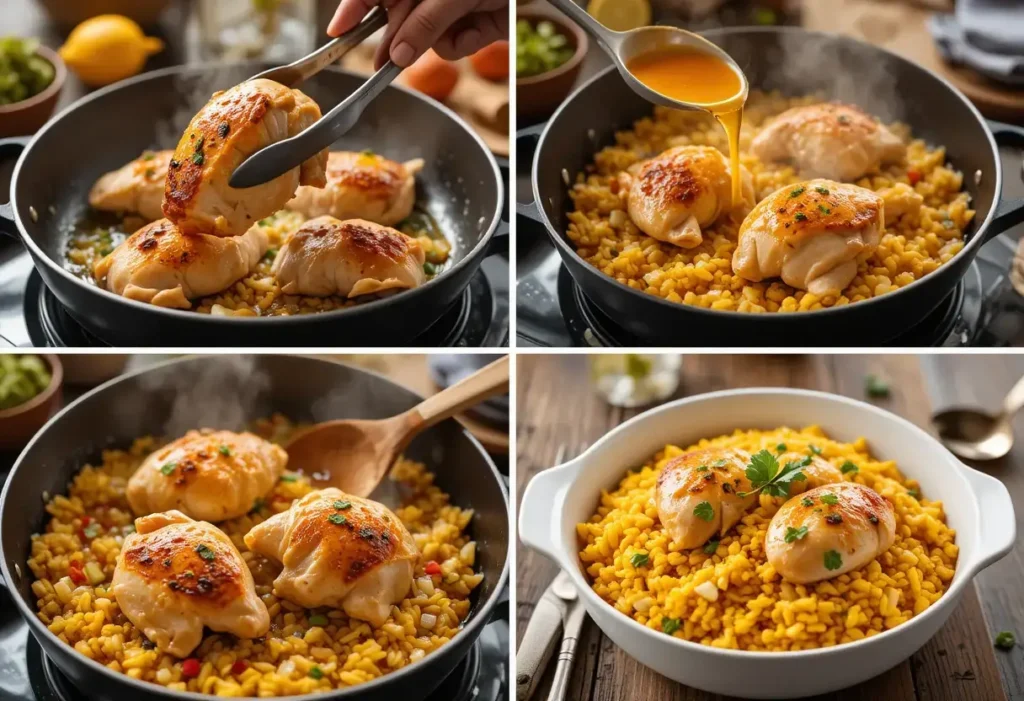Chicken and yellow rice is a beloved dish celebrated for its vibrant flavors, comforting warmth, and versatility. A staple in many households, this dish is easy to prepare and offers endless customization options. Combining tender chicken, aromatic spices, and fluffy, golden-colored rice, it creates a meal that pleases the palate and nourishes the soul. The beauty of chicken and yellow rice lies not only in its simplicity but also in its ability to cater to a wide array of culinary preferences.
The foundation of this dish is its saffron- or turmeric-infused rice, lending a rich yellow hue and subtle earthiness. Paired with seasoned chicken, it achieves a balance of flavors that is both satisfying and harmonious. Whether served as a weeknight dinner or a celebratory centerpiece, chicken and yellow rice holds universal appeal, making it a go-to recipe for novice cooks and experienced chefs alike.
Table of Contents
Historical Significance and Regional Variations
The roots of chicken and yellow rice can be traced back to multiple culinary traditions, each adding its unique twist. The dish draws inspiration from Spanish, Middle Eastern, and South Asian cuisines, where rice and poultry are staples of the diet. The influence of saffron, a prized spice originally cultivated in the Middle East, is a nod to the luxurious origins of this simple yet elegant meal.
In Spain, Arroz con Pollo (chicken with rice) showcases the marriage of Moorish spices and local ingredients, often featuring bell peppers, tomatoes, and peas for added texture and flavor. Latin American adaptations of the dish frequently incorporate achiote or annatto for their characteristic color and flavor, reflecting indigenous cooking methods. Meanwhile, South Asian versions like biryani introduce a complex layering of spices and herbs, elevating the dish to new heights.
Each region has adapted chicken and yellow rice to suit local tastes and ingredients. Caribbean interpretations often include coconut milk for a creamy, tropical touch, while North African variations might introduce preserved lemons and olives for a tangy twist. Regardless of the adaptation, the essence of the dish remains: a harmonious blend of flavors that brings people together at the table.
This guide will walk you through the steps to create your own chicken and yellow rice masterpiece, whether you’re aiming for a traditional recipe or a personalized take.
Ingredients List
Essential Ingredients for Chicken and Yellow Rice
To prepare a flavorful and hearty chicken and yellow rice dish, you’ll need the following core ingredients in the recommended quantities (serves 4):
- Chicken: 4 bone-in, skin-on chicken thighs or 2 cups of shredded cooked chicken (optional: chicken breast or drumsticks).
- Rice: 2 cups of long-grain rice or basmati rice, rinsed.
- Broth: 4 cups of chicken broth (low sodium preferred for better control of salt levels).
- Onion: 1 medium onion, finely chopped.
- Garlic: 3 cloves, minced.
- Bell Pepper: 1 medium bell pepper (red, yellow, or green), diced.
- Olive Oil or Butter: 2 tablespoons for sautéing.
- Tomatoes (optional): 1 medium tomato, diced, or ½ cup of canned diced tomatoes.
Recommended Spices and Seasonings
The spices and seasonings are key to achieving the rich flavors and golden color of chicken and yellow rice. Here’s what you’ll need:
- Turmeric or Saffron:
- 1 teaspoon of turmeric (budget-friendly option for vibrant color).
- ½ teaspoon of saffron threads, steeped in warm water (for a luxurious touch).
- Paprika: 1 teaspoon for a smoky, mild flavor.
- Cumin: ½ teaspoon for a warm, earthy note.
- Bay Leaf: 1, for added depth.
- Salt and Black Pepper: To taste.
- Parsley or Cilantro: Chopped, for garnish.
Optional seasonings to enhance the dish:
- Cayenne Pepper or Chili Powder: For a hint of spice.
- Oregano or Thyme: ½ teaspoon for a subtle herbal flavor.
Substitutions for Common Allergens
To ensure this dish is accessible to everyone, consider these substitutions for common allergens:
- Gluten-Free:
- Use certified gluten-free chicken broth.
- Avoid spice blends that may contain hidden gluten.
- Dairy-Free:
- Replace butter with olive oil or a dairy-free butter alternative.
- Vegetarian or Vegan:
- Substitute chicken with plant-based proteins like tofu, tempeh, or chickpeas.
- Use vegetable broth instead of chicken broth.
- Low-Sodium Option:
- Use homemade or low-sodium broth and control salt levels manually.
- Nut-Free:
- Ensure all spice blends and ingredients are nut-free, as cross-contamination may occur in prepackaged items.
By tailoring the ingredients and spices to your dietary needs and preferences, you can create a delicious chicken and yellow rice dish that everyone can enjoy!
Step-by-Step Cooking Instructions
Preparing the Chicken
- Season the Chicken: Pat the chicken pieces dry with a paper towel. Season both sides with salt, pepper, and a pinch of paprika for added flavor.
- Sear the Chicken:
- Heat 2 tablespoons of olive oil or butter in a large, deep skillet or Dutch oven over medium-high heat.
- Place the chicken pieces skin-side down and sear until golden brown, about 4-5 minutes per side. This step locks in moisture and enhances flavor.
- Remove the chicken from the skillet and set it aside on a plate. Leave the drippings in the pan for the next steps.
- Optional Shredded Chicken: If using pre-cooked chicken, shred it into bite-sized pieces and set it aside to add later in the cooking process.
Cooking the Yellow Rice Perfectly
- Sauté Aromatics:
- In the same skillet, add the chopped onion, minced garlic, and diced bell pepper.
- Sauté over medium heat until softened and fragrant, about 3-4 minutes.
- Toast the Rice:
- Add the rinsed rice to the skillet, stirring to coat it in the oil and aromatics.
- Cook for 1-2 minutes until the rice becomes slightly translucent and takes on a nutty aroma.
- Add Spices:
- Stir in turmeric (or steeped saffron liquid), cumin, paprika, and any additional spices of choice.
- Ensure the rice is evenly coated for vibrant color and flavor.
- Incorporate Broth:
- Pour in the chicken broth, gently stirring to distribute ingredients evenly.
- Add a bay leaf and season with salt and pepper to taste.
- Simmer the Rice:
- Bring the mixture to a boil, then reduce the heat to low.
- Cover the skillet with a tight-fitting lid and let the rice simmer for 15-18 minutes, or until the liquid is absorbed and the rice is tender.
Combining Ingredients for Optimal Flavor
- Reintroduce the Chicken:
- Nestle the seared chicken pieces into the rice, ensuring they are partially submerged for even cooking.
- If using shredded chicken, fold it gently into the rice during the last 5 minutes of cooking.
- Allow to Rest:
- Once the rice is cooked and the chicken is fully heated through, remove the skillet from heat.
- Let the dish rest, covered, for 5 minutes. This allows the flavors to meld and the rice to finish steaming.
- Garnish and Serve:
- Discard the bay leaf.
- Garnish the dish with freshly chopped parsley or cilantro for a pop of color and freshness.
- Serve hot, straight from the skillet, with optional sides like a simple salad or roasted vegetables.
By following these steps, you’ll achieve a perfectly balanced chicken and yellow rice dish that’s flavorful, aromatic, and irresistibly satisfying.
Cooking Techniques and Tips
Tips for Juicy Chicken Every Time
- Choose the Right Cut: Bone-in, skin-on chicken thighs retain moisture better during cooking. If using breasts, avoid overcooking as they dry out quickly.
- Pat Dry Before Cooking: Removing excess moisture helps achieve a golden, crispy exterior when searing.
- Don’t Overcrowd the Pan: Sear chicken in batches if necessary to ensure even browning and prevent steaming.
- Cook to Temperature: Use a meat thermometer to check that the internal temperature of the chicken reaches 165°F (74°C) for safe consumption.
- Let It Rest: After cooking, allow the chicken to rest for a few minutes. This redistributes juices, keeping the meat tender and juicy.
Secrets to Fluffy and Fragrant Yellow Rice
- Rinse the Rice: Wash rice in cold water until the water runs clear. This removes excess starch, preventing clumping.
- Toast the Rice: Lightly toasting the rice in oil or butter before adding liquid enhances its flavor and creates a nutty aroma.
- Use the Right Liquid Ratio: A standard 1:2 rice-to-liquid ratio works for most long-grain varieties, but adjust based on the specific type of rice.
- Don’t Lift the Lid: Avoid uncovering the pot while the rice is cooking, as it disrupts the steaming process.
- Fluff with a Fork: Once cooked, fluff the rice gently with a fork to separate the grains and maintain its light texture.
Adjusting Cooking Times for Different Rice Types
- Long-Grain White Rice: Cooks in 15-18 minutes; perfect for achieving fluffy, separate grains.
- Basmati Rice: Requires 12-15 minutes; rinse thoroughly to remove excess starch.
- Jasmine Rice: Cooks in 10-12 minutes; slightly stickier texture ideal for some variations.
- Brown Rice: Needs 40-45 minutes; increase liquid to 2.5 cups per cup of rice for proper hydration.
- Arborio Rice: For a creamier texture, use less liquid initially and stir frequently, similar to risotto preparation.
Nutritional Information
Caloric Content of Chicken and Yellow Rice
- Per Serving (approximate):
- Calories: 400-500 (depending on portion size and added fats).
- Protein: 25-30 grams (from chicken and broth).
- Carbohydrates: 50-60 grams (from rice).
- Fats: 10-15 grams (from chicken skin, oils, or butter).
Health Benefits of the Main Ingredients
- Chicken:
- High in protein, supporting muscle repair and growth.
- Provides essential nutrients like vitamin B6, niacin, and phosphorus.
- Rice:
- A good source of energy and complex carbohydrates.
- Brown rice offers more fiber, supporting digestion and heart health.
- Spices:
- Turmeric contains curcumin, known for its anti-inflammatory and antioxidant properties.
- Garlic and onion contribute to immune-boosting and heart-protective effects.
- Vegetables:
- Bell peppers and tomatoes provide vitamins A and C, promoting skin health and immunity.
Dietary Considerations: Gluten-Free and Vegan Options
- Gluten-Free:
- Ensure all ingredients, including broth and spices, are certified gluten-free.
- Avoid prepackaged spice blends that may contain hidden gluten.
- Vegan:
- Substitute chicken with plant-based proteins like tofu, tempeh, or lentils.
- Use vegetable broth instead of chicken broth.
- Enhance flavor with nutritional yeast or a splash of coconut milk.
- Low-Sodium:
- Use homemade or low-sodium broth to control salt levels.
- Season with herbs and spices instead of relying on salt for flavor.
By incorporating these tips and adaptations, you can enjoy a versatile, healthful chicken and yellow rice dish tailored to your dietary needs.
Common Mistakes to Avoid
Overcooking the Rice
- Too Much Liquid: Adding more broth than necessary can result in mushy rice. Stick to the correct rice-to-liquid ratio and adjust for the type of rice used.
- Cooking on High Heat: Keep the heat low during simmering to allow the rice to absorb liquid evenly without burning the bottom.
- Not Timing Properly: Overcooking the rice can turn it into a sticky, clumpy mess. Monitor the cooking time closely and test the texture as needed.
Underseasoning or Overseasoning the Dish
- Forgetting to Taste as You Cook: Adjust seasoning incrementally to avoid an overly salty or bland dish.
- Skipping Key Spices: Ingredients like turmeric, cumin, or saffron are essential for flavor and color—don’t leave them out.
- Heavy-Handed Spices: Overusing strong spices like paprika or cayenne can overpower the dish. Balance is key.
Advanced Variations
Incorporating Different Meats or Seafood
- Other Poultry:
- Substitute chicken with turkey thighs or duck for a richer flavor.
- Seafood:
- Add shrimp, mussels, or scallops for a coastal twist. Incorporate them during the last 5 minutes of cooking to prevent overcooking.
- Chorizo or Sausage:
- Include sliced chorizo or a smoked sausage like kielbasa for an added layer of spice and smokiness.
Vegetarian and Vegan Variations of the Recipe
- Plant-Based Proteins:
- Use tofu cubes, tempeh, or seitan seasoned with spices for texture and protein.
- Vegetable Medley:
- Add hearty vegetables like zucchini, carrots, green beans, or chickpeas for bulk and flavor.
- Coconut Rice:
- Replace some of the broth with coconut milk for a creamy, vegan-friendly version.
- Herb-Forward Garnishes:
- Top the dish with fresh basil, cilantro, or mint to enhance the flavor profile.
Storing and Reheating
Best Practices for Storing Leftovers
- Cool Quickly:
- Allow the dish to cool to room temperature within 2 hours to avoid bacterial growth.
- Airtight Containers:
- Transfer leftovers to an airtight container to preserve freshness and prevent odor absorption.
- Refrigerate or Freeze:
- Store in the refrigerator for up to 3 days or in the freezer for up to 3 months for longer preservation.
How to Reheat for Best Taste and Texture
- Reheating on the Stovetop:
- Add a splash of broth or water to a skillet and reheat the rice on low heat, stirring occasionally to prevent sticking and ensure even heating.
- Using the Microwave:
- Place the rice in a microwave-safe dish, sprinkle it with water or broth, and cover with a damp paper towel. Heat in short intervals, stirring between each session.
- Avoid Overheating:
- Overheating can dry out the chicken and rice. Heat only until warmed through for best results.
By following these tips, you can enjoy the full flavors of chicken and yellow rice even after storing and reheating, while experimenting with advanced variations to keep the dish exciting!
FAQs
How Can I Make My Chicken and Yellow Rice More Flavorful?
- Use Homemade Broth: Homemade chicken broth adds depth and a richer taste compared to store-bought options.
- Layer Spices: Toast spices like turmeric, paprika, and cumin in oil before adding the rice to amplify their flavor.
- Incorporate Aromatics: Sauté onions, garlic, and bell peppers for a fragrant base.
- Add Fresh Herbs: Garnish with chopped parsley, cilantro, or scallions for a burst of freshness.
- Enhance with Citrus: Squeeze fresh lemon or lime juice over the dish just before serving for a tangy kick.
Can I Cook Chicken and Yellow Rice in a Rice Cooker?
Yes, you can easily prepare chicken and yellow rice in a rice cooker. Follow these steps:
- Pre-Cook Chicken: Sear or fully cook the chicken in a skillet before adding it to the rice cooker.
- Combine Ingredients: Add rinsed rice, pre-cooked chicken, broth, spices, and aromatics directly to the rice cooker.
- Set the Cooker: Use the white rice or regular cooking setting. For brown rice, select the appropriate setting and adjust the liquid ratio.
- Mix After Cooking: Once the cycle is complete, gently fluff the rice and incorporate the chicken evenly.
What Are Some Common Side Dishes That Go Well With Chicken and Yellow Rice?
- Simple Salads:
- A fresh green salad with vinaigrette complements the hearty dish.
- Cucumber and tomato salad adds a refreshing touch.
- Vegetables:
- Roasted or steamed vegetables like asparagus, broccoli, or carrots balance the meal.
- Sautéed spinach or collard greens provide a nutritious side.
- Bread:
- Warm dinner rolls or crusty bread help mop up any flavorful juices.
- Pickled Items:
- Pickled onions or jalapeños add tangy contrast.
Conclusion
Cooking chicken and yellow rice offers a delicious way to explore culinary traditions while creating a meal that suits various dietary needs. For inspiration, check out Mini Chicken Pot Pies for another comforting chicken dish, or explore Southern Cornbread Recipes as a perfect side. For seafood enthusiasts, try incorporating ideas from the Shrimp Burrito Guide to elevate your meal.
Enjoy experimenting and making this dish your own!




